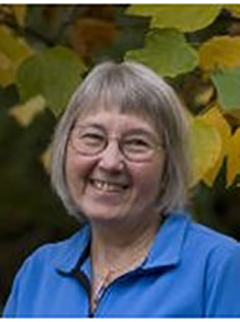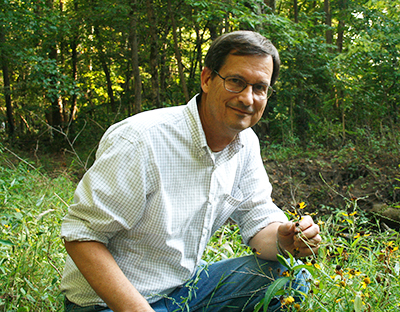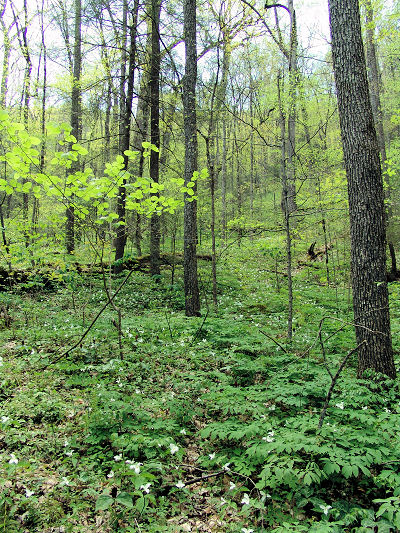Need help identifying a native plant? Websites with good photos can help you confirm a suspected ID or quickly eliminate a way-off incorrect one. Be aware, though, that many photos on the Internet are misidentified. Always cross-check with standard references. Here is some guidance from our experts.
References on Indiana Native Plants
Paul Rothrock’s Picks
 Dr. Paul Rothrock, Associate Curator Emeritus, Biology, at Indiana University Bloomington recommends these sites:
Dr. Paul Rothrock, Associate Curator Emeritus, Biology, at Indiana University Bloomington recommends these sites:
www.midwestherbaria.org
This website is a rich source of information about preserved plant specimens gathered over several centuries from the Midwest region. A comprehensive database of specimens from Indiana University Herbarium, Morton Arboretum, Butler University, and others can be searched and mapped. In addition to Ecoregion species lists, custom checklists can be created and downloaded. The site includes notes about Indiana species (especially from Charles Deam), numerous photos, and a unique identification tool.
michiganflora.net
The University of Michigan Herbarium houses the most comprehensive collection of Midwest plant specimens and has produced both a print and web version of the Michigan Flora. This site uses technical language and keys, so it is not for a beginner; but it includes many fine photos, even of non-showy groups such as grasses, sedges, and rushes.
www.minnesotawildflowers.info
Although this website focuses on Minnesota, many of the same species occur in Indiana. Great for the beginner as well as the initiated. It contains hundred of high-quality images and some useful identification tools for technical plant families.
Becky Dolan’s Picks
 Dr. Rebecca Dolan of Friesner Herbarium, Butler University, recommends these sites:
Dr. Rebecca Dolan of Friesner Herbarium, Butler University, recommends these sites:
plants.usda.gov
The USDA Plants website has lots of good information and is very easy to use. You can search on common or scientific name. Pages for each plant have distribution maps for the U. S. and Canada (so you can quickly see if a plant is known to grow in Indiana) and usually several photos and line drawings. Other useful information includes whether the species is native or not, synonyms (other names under which the plant has been known), plant family, life form (tree, shrub, etc.), duration (annual, perennial, etc.), and whether the plant is listed as rare or endangered or, conversely, is considered invasive anywhere in its range. Some plants have photographs of the seeds. The site is fairly frequently updated. A shortcoming is that many of the common names listed are unusual and certainly not in common use in Indiana.
www.tropicos.org
Tropicos is maintained by the Missouri Botanical Garden and is arguably the online source authority for currently accepted scientific names. Formal plant names are constantly in flux as botanists rethink the range of variation that can be considered to constitute a single species and as historical treatments are reconsidered and reapplied. Work on the on-going Flora of North America multi-volume series has lead to a lot of recent changes. The Tropicos site can be searched by common and scientific name, has literature citations for taxonomic treatments, lists synonyms, and has images of living plants, and sometimes herbarium sheets, for each taxon. Spoiler alert: Many name changes have come through in the last few years, including changes in genus for most species formerly classified at Asters in Indiana. Some of your favorite, familiar scientific names may be history.
www.missouriplants.com
The Missouri Plants site excels because of its fine photographs. Many Indiana plants also grow in Missouri. This site has a brief key you can click on based on flower color and leaf arrangement. You can scan through images to find the plant you are looking for. The individual plant pages have descriptions and details illustrated by beautiful close-up photos of plant parts like leaves and stems, often showing the range of variation that can be found in a single individual.
www.ct-botanical-society.org
Connecticut Botanical Society provides good photographs along with information about plants. You can search by flower color.
www.mobot.org/gardeninghelp/plantfinder
The Kemper Garden Center at the Missouri Botanical Garden has pictures, plant information, and sources for many natives that are in the horticultural trade. You can search by scientific or common name. Through their PlantFinder, you can also search by preferred habitat, growth form, use (water plant, attracts butterflies, dried flowers, etc), and other characteristics, like good fall color.
www.google.com
At the Google site, select to search through images instead of the web, which is mostly text-based material. In Google image search, typing in a plant name usually yields many images. These can be posted by anyone, so there are often errors. It helps to search on the scientific name, but even then you can’t be sure of the ID, although looking through a page or two of images will give you the sense of “majority rules” on what is likely the correct plant. Click on the image to go to the original website to judge for yourself how authoritative a source it seems. Kay Yatskievych offers the tip that she scans the images for those on sites that end in “.edu” and are therefore affiliated with academic institutions. They tend to be more reliable, but there are no guarantees.
Kay Yatskievych’s Indiana Plant Identification Aids
 Kay Yatskievych, Missouri Botanic Garden Research Associate and author of Field Guide to Indiana Wildflowers (2000), is hard at work on The Indiana Vascular Plants Catalogue, which will be the first comprehensive list of species published since 1982.
Kay Yatskievych, Missouri Botanic Garden Research Associate and author of Field Guide to Indiana Wildflowers (2000), is hard at work on The Indiana Vascular Plants Catalogue, which will be the first comprehensive list of species published since 1982.
Kay’s website has downloadable PDFs of an Indiana Spring Wildflower Finder that presents images of 112 of the approximately 300 species that come into bloom February through April. Also on the site are 28 Indiana Species Pages and a Character Comparison Page for the early leaves of Waterleaf (Hydrophyllumn) species.
Kay also recommends www.vplants.org, a “virtual herbarium” of the Chicago region that includes seven counties in northwest Indiana.
Kay is willing to help with your hard-to-identify images or specimens. Contact her at Kay.Yatskievych@mobot.org.
Resources from Neighboring States
Detailed accounts of wildflowers grouped by specific plant communities are found at Prairie Wildflowers of Illinois.
Good scholarly resources are the Wisconsin State Herbarium and Native Plants Journal.


